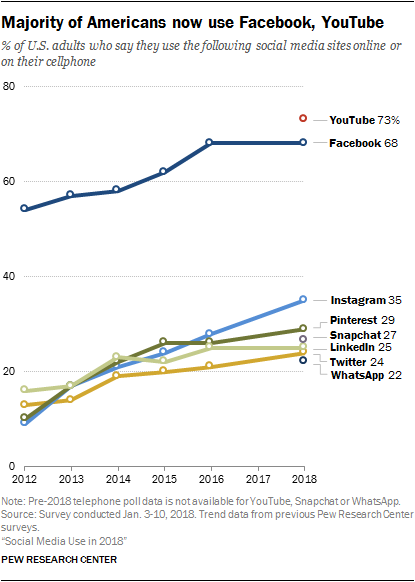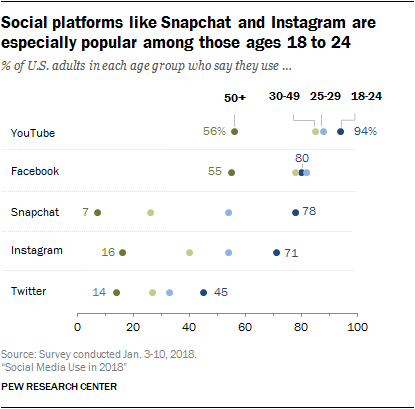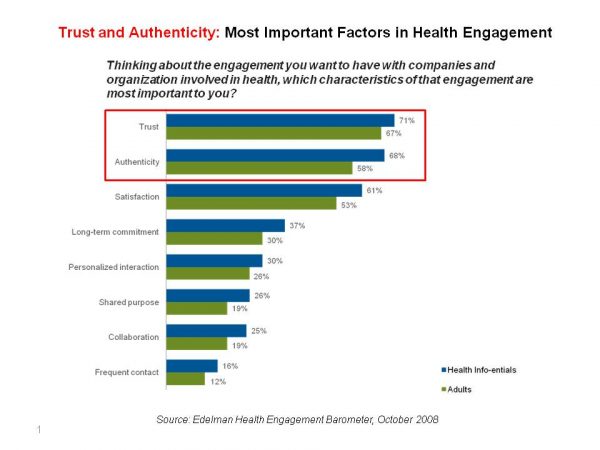The median American uses 3 social networking platforms in 2018.
Facebook is the primary platform for most Americans who use social media in 2018: two-thirds of U.S. adults use Facebook, and 3 in 4 of them check in on a daily basis.
But in the past year, the percentage of people using Facebook and its corporate sister YouTube has flattened, based on the survey report, Social Media Use in 2018 from the Pew Research Center. The Pew team researched U.S. adults’ use of social media across eight popular platforms.

Instagram has gained consumer favor over the past two years, with 35% of U.S. adults using the site compared with 68% using Facebook. The growth of Instagram use has been heavy among young adults age 18-24, 71% of whom now use Instagram.
The first chart from the Pew study illustrates that there are several other social networks tightly clustered in terms of use beyond Instagram, including Pinterest, Snapchat, LinkedIn, Twitter, and WhatsApp.

Check out social media use by age cohort, shown in the second chart. Social media use varies by age cohort, with:
- 9 in 10 young adults age 18-29 using at least one social network
- 8 in 10 people age 30-49 using a social platform
- 2 in 3 people 50-64 on a social network, and
- Nearly 4 in 10 people 65 and older using at least one social network.
There are important demographic differences in social network use to call out:
- More women than men use Pinterest
- People with more education and higher incomes tend to use LinkedIn more (50% with college degrees vs. 9% with high school or less)
- WhatsApp is especially popular among people with Hispanic ethnicity vis-a-vis 14% of white adults and 21% of black adults.
Only 3 % of social media users say they have a lot of trust in information they find on these sites. Furthermore, most do not believe their personal information is protected from “bad actors” on these sites.
The Pew Research Group polled 2,002 U.S. adults age 18 and over in early January 2018 for this study.
Health Populi’s Hot Points: Health is social: isolation is a social determinant for ill health. Social networks have been found to be very helpful for peer-to-peer healthcare, a concept that Susannah Fox unearthed when mining Pew survey data she analyzed when she led the organization’s pioneering work on the Internet’s growing role in healthcare.

This new study on social media use in 2018 has important implications for healthcare and for attendees of the annual HIMSS conference this year. The obvious pearl is that not all social networks fit all people: when you’re a marketing a health care service or product, know your end-user’s media preferences. That’s pretty 101 stuff, but here we can see that, at a simple level, Pinterest might be better used for a specific woman’s health program and LinkedIn for, say, a campaign to boost employee savings in HSAs.
Underneath the market segmentation/media preference issues, though, remember that trust is a pre-condition for health engagement. We learned from the first Edelman Health Engagement Barometer that the three top factors that consumers look for when health-engaging with any organization are trust, authenticity, and satisfaction.
Social media users informed the Pew study that they don’t tend to trust personal data shared across the eight dominant social networks.
This begs the question, then, how to leverage the important social platform for the betterment of health, healthcare, and patient and caregiver engagement? What’s so powerful about social is that it can scale care and support from an N of 1 to an N of many.
At #HIMSS18, we will see the usual health IT suspects in the mix this year with newer entrants who are opening up health data to better flow and liquidity across data siloes. We’ll see voice-first developers like Orbita, which appeared at HIMSS last year, expanding tools for health-focused digital voice assistants; I learned about their Alexa skills in 2017 developed for people dealing with aging at home. 46% of U.S. adults used in 2017, according to a survey Pew conducted last year.
Apple is a presence at HIMSS18, collaborating with some tech-savvy hospitals, and recently announcing its foray into electronic health records innovations for better patient access.
Orbita builds Alexa tools over Amazon, and Apple, like Amazon, is a beloved, trusted consumer-facing brand. In fact, as many U.S. consumers trust retail and digital health companies to help them manage health as they trust healthcare providers, I explained in this Health Populi post.
Social networks are well-used by patients. Instagram was recently found to be a platform that might be helpful for some people dealing with mental and behavioral health issues. That can only happen when trust is baked into the experience. This week in Vegas, as I kick the tires of various health tools and apps whose objective is to engage people in health-making and shared decision-making, I’ll also be seeking that trust ingredient in terms of transparent privacy policies, data stewardship, and commitment to real and sustained patient and population health.
The post What the Latest Pew Consumer Data Means for #HIMSS18 appeared first on HealthPopuli.com.
What the Latest Pew Consumer Data Means for #HIMSS18 posted first on http://drugsscreeningpage.blogspot.com/
No comments:
Post a Comment